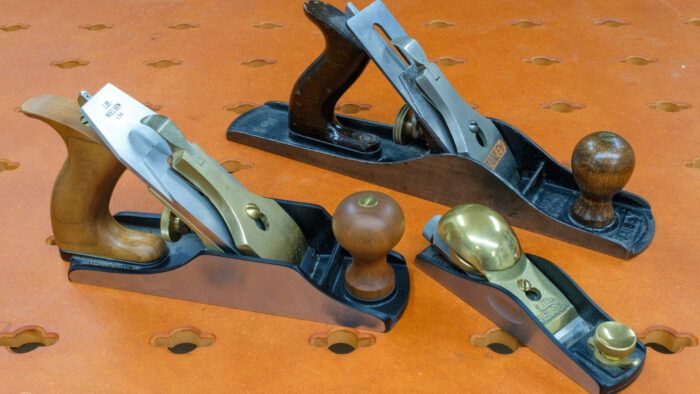My top three
If you're blending hand tools and power tools in your shop, here are the planes you should own.
Despite writing books on how to work with hand tools, I do use machines and power tools in the shop. I do so because I can, but I certainly don’t need them to woodwork. That was the point of The Minimalist Woodworker books. I wanted to highlight that people can make beautiful wooden objects without machines and power tools. Even so, I believe the best solution for me (and quite a few others) is to work in a blended way with both hand and power tools.
There is a lot of info about what power tools you “need” in order to work, but there isn’t much on how to blend in some hand tools to complement those machines. There are three top planes that I tend to gravitate toward when working in my shop. Keep in mind that the brand of the tools is not that important, though I will caution you for your own sanity to stay away from cheap, poorly made planes. They can make simple tasks difficult and frustrating. As my father Livio Tesolin used to say, “Buy a good tool and you only cry once. Buy garbage and you cry and cry and cry.”
These are my three go-to planes for a blended shop.
Jack
This tool can be used for a variety of tasks, kind of like a jack of all trades! In my shop, it only gets used to flatten stock that is too wide for my jointer. I can comfortably flatten material up to 500mm (20 in.) wide with my jack and even wider with a bit more care. The blade is fairly cambered with the corners backed off about 1mm (0.039 in.) because I want to work quickly and I’m not overly concerned about surface quality at this point.
Smoother
Regardless of the machine you use to surface your components, there is always the need to remove machine marks (unless you have a Super Surfacer, you lucky duck). Even the best helical cutterheads leave their marks behind. Enter the smoother. On mild woods that tolerate planing well, there is no better surface than that left by a handplane. The surface is glossy-smooth and free of blemishes. Not all woods will plane well, and these are best sanded. But for the ones that do plane well, I love bringing the surface to life with a smoother.
Block
The block plane is perfectly suited to working on the end grain of boards. The low blade presentation and keen blade make short work of these surfaces. Power saws will always leave marks on end grain, sometimes not visible until the finish is applied. Other times, a dull blade can leave nasty burns and deep scratches in the end grain. The block plane can fix these issues while your power blades are out being sharpened. I also use mine to create delicate chamfers and roundovers, or to sharpen the odd pencil.
The key to all of these tools, of course, is to have a sharp blade and some practice. They take no more time to master than a table saw or router and they can really take your work to the next level. If you have a shop full of machines and power tools, these are the three planes that I feel are the most useful to add. I would be lost without my trio to be sure.
 |
The Types of Handplanes |
 |
How to Put a Plane Down |
 |
Tips and Tricks for Handplaning |
Fine Woodworking Recommended Products

Olfa Knife

Veritas Precision Square

Bahco 6-Inch Card Scraper























Log in or create an account to post a comment.
Sign up Log in